The project aims at sensitizing the viewer to the importance and quality of the value of darkness - it teaches respect for the night time.
It shows that light allows transforming landscape into spatial systems thus revealing their uniqueness and peculiarity, which has a positive impact on people.
As a result we feel more open and integrated, full of energy and power for further activity.
The goal of the project is to redefine the concept of darkness and to demonstrate, based on the example of the Botanical Garden of the University of Wrocław, that the expansion of over-lighting remains an anachronistic approach. The designed illumination of the Garden proves that it is time to break the paradigms of using lighting and the proper moment has come to implement the policy of minimum levels of light intensity - especially in the areas intended for pedestrians. Our project illustrates that adopting the right amount and the proper spectrum of light for the benefit of urban ecosystems constitutes a powerful tool supporting the Sustainable Development Goals, which include the following issues:
Good quality of education - an evening walk in the area of the Botanical Garden increases the awareness of nature and teaches sensitivity;
Sustainable cities and communities - illumination promotes wide access to safe green areas in cities;
Climate -low light intensity discovers the value of darkness, thus reducing energy consumption;
Life on a land - illumination has been adapted to the biorhythm of fauna and flora and to the human biological clock.
Moreover, the project is an example of using nature as an inspiration and night time as a source of aesthetic benefits. We show how illumination creates social values and evokes reflection on nature. The project we have developed reveals how to use the night time to become more connected with nature, in full understanding of the changing day-night cycles.
The illuminated space invites us to walk along the line of feelings, where our sensory abilities become sharper while, simultaneously, nature becomes closer to us.
The intention of the project is to make the Botanical Garden a practical domain for learning about light, night, fauna, flora, as well as human behavior and feelings. All details have been prepared in line with the idea that the celebration of the night time is a challenge for the future.
Please highlight how the project can be exemplary in this context
The fall-winter illumination of the Botanical Garden is the event held systematically since 2019. It was initiated in the fall of 2019, as part of the conference entitled “Difficult Landscapes”, to start the discussion on the problem of protecting both the landscape and the environment from light pollution. The event was continued in 2020 and 2021 and lasted a few weeks in the winter period. Currently, the efforts are made to ensure that the winter and autumn illumination of the Botanical Garden is a permanent event held in the period from November 1 till March 1, and occasionally also taking place in the spring and summer periods. Due to illumination going on for three years now, the Botanical Garden in Wrocław has become the place of searching for harmony and balance between light and darkness.
The installation we have created is one of the first attempts in Poland to develop a model approach to the illumination of green areas, paying attention to the life cycle of fauna and flora in urban areas. These activities focus on the new standards of lighting solutions which do not damage the element of shadow. The installation indicates precisely the appropriate balance between light and darkness.
The light was approached as a medium which offers its residents an evening experience with nature. The project is an example showing that, even without interfering with the structure of the area, the light allows transforming the landscape fragments into spatial arrangements, thus revealing their uniqueness. This is an example presenting how city gardens and parks can remind us of the landscape night-time dimension.
In 2021, 300 RGBW LED lighting fittings and 50 signaling fittings made according to an individual project were used to create the illumination. They consumed a total of 10 kW of energy per hour. This translates into the running cost of the entire installation of only approx 3 Euro per hour.
Please highlight how the project can be exemplary in this context
The main goal of the submitted project is to show that experiencing nature at night can result in the abundance of sensations, whereas introducing a small amount of light allows experiencing both the depth and meaning of the night with high intensity.
The light skillfully applied to the night scenery allows extracting the sequence of views from a deep perspective of darknessin the painterly way. This proves that in order to implement light into the landscape in a responsible manner, the darkness has to be analyzed in the first place.
The aesthetics is created by nature itself, which is composed in terms of corridors and rooms of landscapes. Some of them were visually connected to the panoramas of the surrounding monuments to strengthen the perspective and construct structural links between the plans and the illuminated elements.
The main purpose of light is to guide the observer according to the line of feeling, designed in the form of a loop.
It is the act of landscape perception in harmony with the line of feelings, associated with the overlapping of different brightness levels, gradients, shadows, depth and a hierarchy of plans. The line of feelings is accompanied by mood, which is created primarily through contrast, rhythm and asymmetry.
Please highlight how the project can be exemplary in this context
The illumination of the Botanical Garden is an example of “lacing” emotional ties between people, the city and nature. Confrontation with nature makes us all equal against it, regardless of class affiliation, wealth and social status. The city gardens and parks represent spaces ready for an eclectic society.In these spaces light is a factor that encourages residents to leave the virtual zone where social life is presentnowadays, like: meetings, learning, shopping and social interactions.
In the Botanical Garden of the University of Wrocław, light plays the role of a “mediator”, it emphasized “micro” details in the natural night landscape. It shows the spatial correlations with the surrounding monuments and encourages social meetings and interactions.
The performed illumination proves that the “monumental” presentation of monuments, which has been practiced in every city so far, should be confronted with the illumination emphasizing the new concept of “closeness” to nature.
The light can be used as a tool to stimulate the sense of social unity, especially if attention is paid to the elements of nature not causing as much social distance as monuments.
Additional Information:
The entry to the Botanical Garden was ticketed from 4:30 p.m. to 8:00 p.m., after 8:00 p.m. admission was free to provide the area to everyone without the obligation of paying a fee. The illumination of the Botanical Garden took place from 4.30 p.m. to 9.00 p.m.
Please highlight how this approach can be exemplary
The project aimed atilluminating the Botanical Garden of the University of Wrocław is an example of designing outdoor lighting in full synchronization with the environment. When selecting plants for illumination, their sensitivity to light was taken into account, and a photoperiod for each of them was carefully determined. To designate the walking route at night time, thelighting fixtures made according to an individual project were used, produced from natural materials coinciding with the materials making up the upper layer of the Botanical Garden area.
As demonstrated by the conducted field studies and the results of the survey carried out among the users in the area of the Botanical Garden, the comfort of movement was already ensured by the lighting intensity of 1lux, i.e. at the level of the full moon lighting. This fact proves that the time has come to break the paradigms of using strong lighting in the environment. It is a proper moment to implement the policy of minimum light intensity levels, especially in the areas intended for pedestrian traffic.
Adopting the right amount and the proper spectrum of light for the benefit of urban ecosystems can prove to be a powerful tool in supporting the goals of sustainable development.
The project presents an example of using nature as an inspiration and the night time as a source of aesthetic experiences, creating social values and mental reflections on the nature.
Its implementation is a message that the night time should remain an integral part of city planning and an important element of the sustainable lighting policy. Therefore, our approach can be considered quite exemplary.
The project shows the city inspired by nature during night time. We have revealed a masterpiece of nature that can be discovered in every city - if not on the Botanical Garden scale then, at least, on the scale of a park fragment, a square or a single tree. Without illumination most of these natural objects are typically hidden in the darkness of the night since too intense artificial light spoils their beauty and contradicts ecological requirements.
The illumination of the Botanical Garden shows how to use the night darkness to connect it with nature in the full understanding of the changing day-night cycles, in accordance with the chronobiology of fauna, flora, with a human being in the center.
Only the so-called long-day plants, such as oaks, beeches, magnolias, pines, spruces were chosen for the evening illumination.
Simultaneously, the light sources emitting waves with the highest potential of impact on the plant development processes were eliminated. The illumination was carried out based on the cross-sectional profile of the Botanical Garden. It means that the range of light wavelengths least interfering with intraspecies and interspecies interactions was assigned to individual organisms. Only these wavelengths were later used for illumination, which took place in the autumn-winter period, when the world of fauna and flora remains inanimate. It should be noted that a human being needs artificial light in this period to eliminate seasonal depression, known as seasonal affective disorder (SAD).
The lighting of the Botanical Garden exposed the unique forms of nature and the relationships between them, taking into account environmental constraints.
An interesting and mystically illuminated space invites us to follow the line of feelings, where our sensory abilities become much sharper making nature closer to us.
Please also explain the benefits that derived from their involvement.
The first illumination project for the Botanical Garden was implemented and installed with the participation of students of landscape architecture at the University of Life Sciences in Wrocław. Students had a chance to experience that the design process is not always continuous. Sometimes it was necessary to take a step back, make adjustments and go through the same stage again. They realized that working with light is particularly difficult in the landscape aspect. This is due to the dual nature of light which, on the one hand, is a medium- necessary for us to objectively and subjectively perceive the existence of things. On the other hand, it is a value in itself - being a physical radiation abiding by the laws of geometric and wave optics and as radiation influences strongly all living organisms. It has the variety of its own form, structure, color and meaning.
During the last illumination in 2021, the landscape effects and the impact of illumination on the viewer were assessed with the help of students of all Wrocław universities. A map of sensations evaluated using a scale of feelings’ intensity was created and a questionnaire for visitors to the Botanical Garden was prepared. All respondents indicated the level of pleasure and a sense of security they had felt while walking.
It turned out that over 55% of the respondents were not familiar with the “light pollution” concept. It is a signal for taking action to popularize education addressing the effects of this problem, especially in the group of people aged 40+. 100% of the oldest survey participants aged 60+ responded “I do not know this issue” in the abovementioned research questionnaire.
The conducted evaluation constitutes the basis for obtaining the best illumination effects in order to make the Botanical Garden a practical and, what is also important, pleasant source for acquiring knowledge about light, fauna, flora, as well as human behavior and feelings.
The project redefines the concept of darkness and demonstrates that the expansion of over-lighting is an anachronistic direction. The night time and illumination is an effective tool to rethink the city aura. It can inspire the society because after dark we are more sensitive, we feel space-time and chronobiology more clearly.
In the survey, the respondents showed that they do not expect every place to be flooded with as much lux as possible. Instead, they expect designers to create conditions in which light shows the nature of the surroundings and gives the opportunity to celebrate the night.
The project implementation showed that creating night spaces with light is a simple and quick action. The execution and evaluation of the final results does not require a long time or a complicated investment process as compared to other forms of landscape transformation. Lighting can be a tool for rapid changes leading to the rediscovery of nature objects and developing a strong relationship with nature.
The project directly implements the goals of sustainable development, such as:
- Good quality of education - an evening walk in the area of the Botanical Garden increases the awareness of nature and teaches consumer sensitivity;
- Sustainable cities and communities – illumination promotes access to safe and green areas in cities,
- Climate - low light intensity discovers the value of darkness, thus limiting energy consumption by reducing lighting levels in cities;
- Life on a land - illumination has been adapted to the biorhythm of fauna and flora and to the human biological clock. This way the practice of biodiversity conservation in urban areas is being developed.
All these goals are united by a common idea - counteracting the effects of light pollution.
The illumination of the Botanical Garden makes people aware that every human is an individual dependent, in fact, on the wealth of ecosystems.As part of a heterotrophic biotic structure we are obliged to introduce carefully even the most innovative lighting technology.
Currently, planning and modernizing the lighting infrastructure in cities, in addition to its high quality, requires taking into account the impact of artificial light on plants, animals and humans.
Disregarding this knowledge at the stage of green transformation of cities will doom any lighting project to failure.
Nowadays, any lighting concept should be considered as missionary - bringing the light, on the one hand, and protecting the darkness of night, on the other.
Therefore, designers, investors and users, should simultaneously become the missionaries of light and shadow.
Demonstrating sustainable alternatives is especially important in Europe, where 90% of the population lives under the light-polluted skies.
Please provide clear documentation, communication of methodology and principles in this context.
The presented project is an attempt to combine nature and modern lighting technology, in accordance with the idea that celebrating the night is the future.
An integrated designing process was used to develop the design, which, in terms of the illumination of the Botanical Garden, is presented in the Diagram No. 1.
The design assumptions with main compositional elements are provided in Scheme no.1, while Scheme no.2 shows the conditions and factors influencing the perception of the landscape.
The obtained illumination effects are the result of a number of activities and choices made at the subsequent stages of the project implementation.
In the course of designing the illumination, one of the most important elements turned out to be the verification of the design through field trials and post-implementation analyzes.
The final stage proves that the lighting design process should never be considered a completely closed form.
Attachments:
1. Diagram no.1- Methodology of the design process
2. Scheme no. 1 - Design assumptions - main compositional elements
3. Scheme no. 2 - Conditions and factors influencing the perception of the landscape
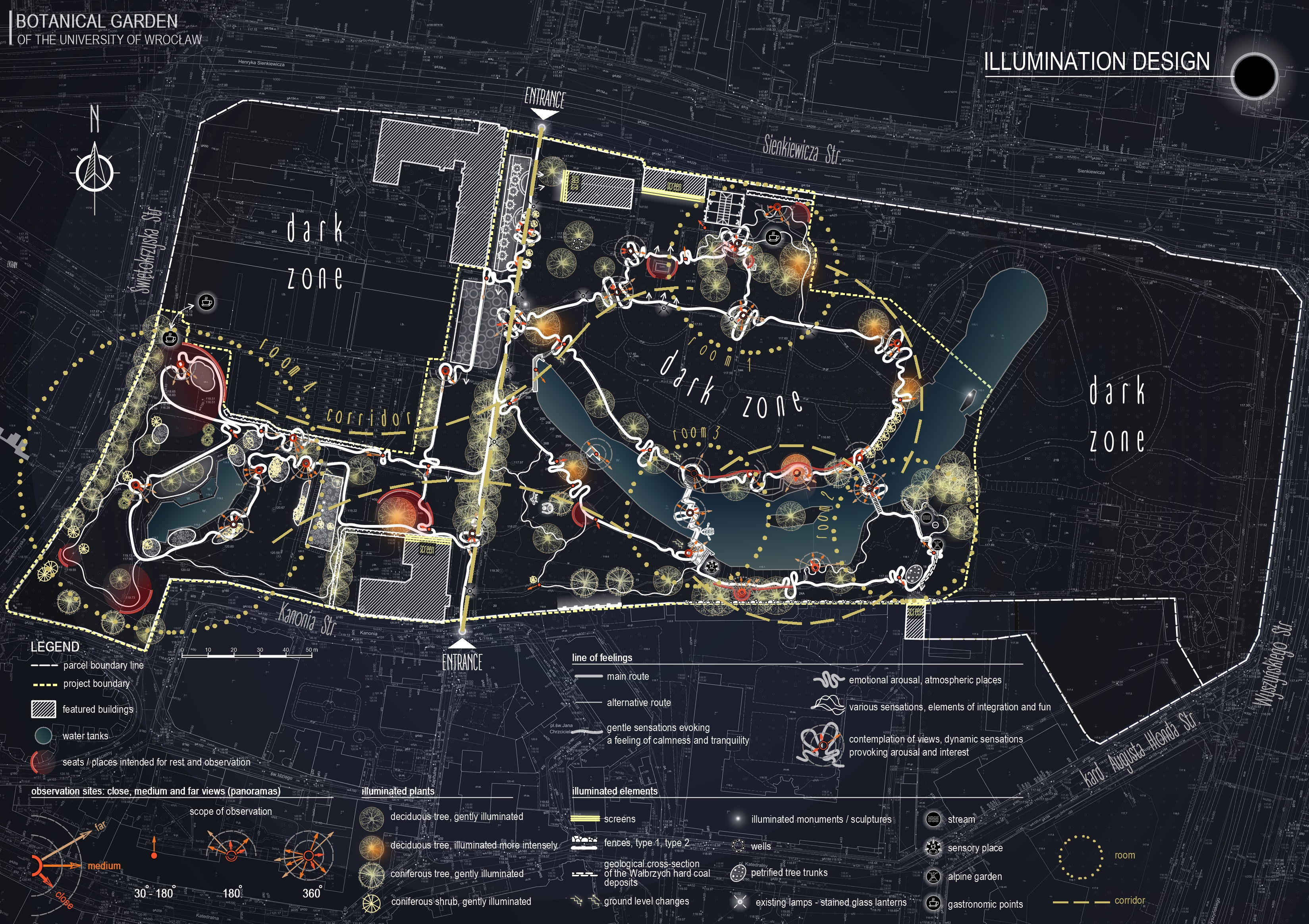
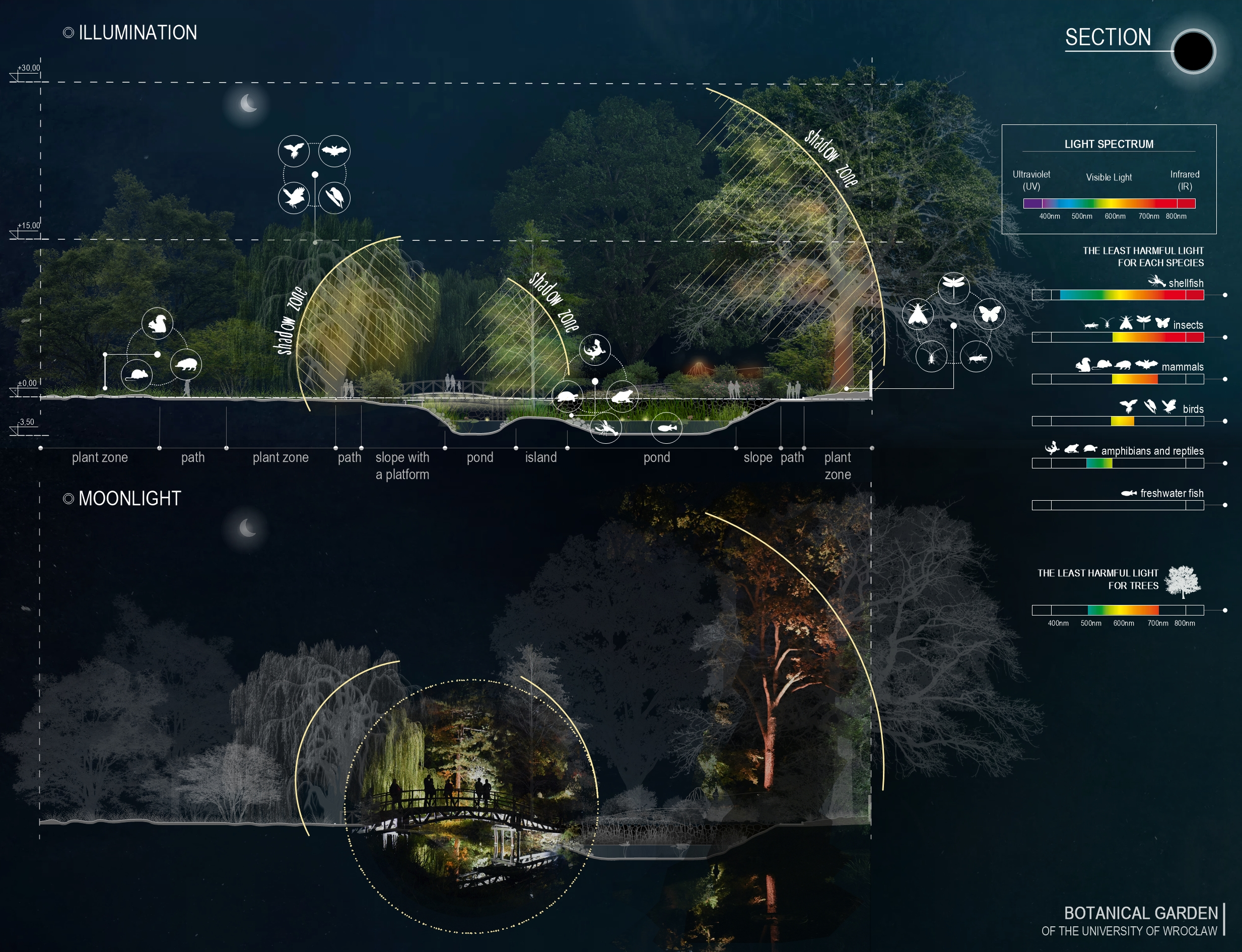
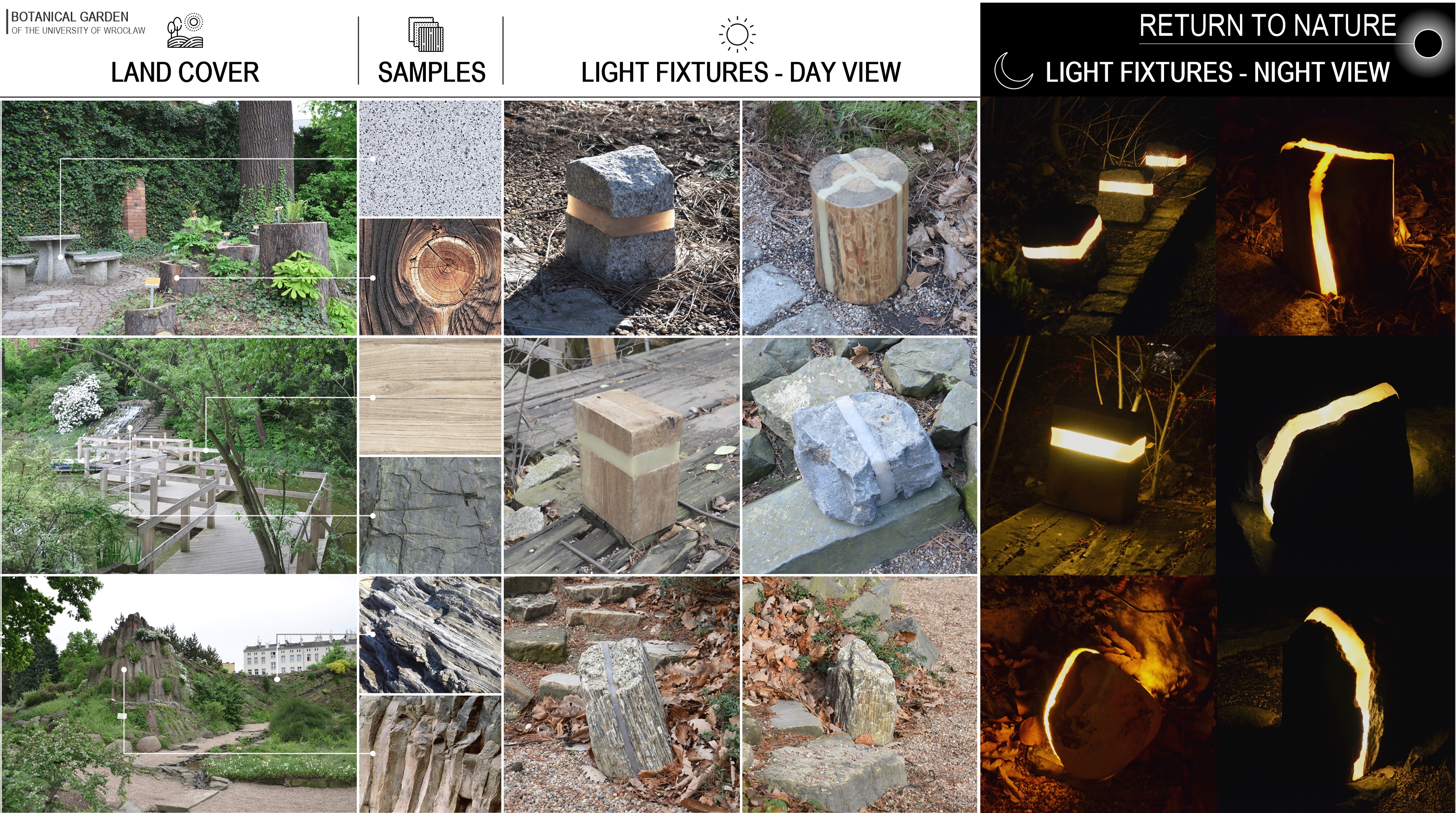
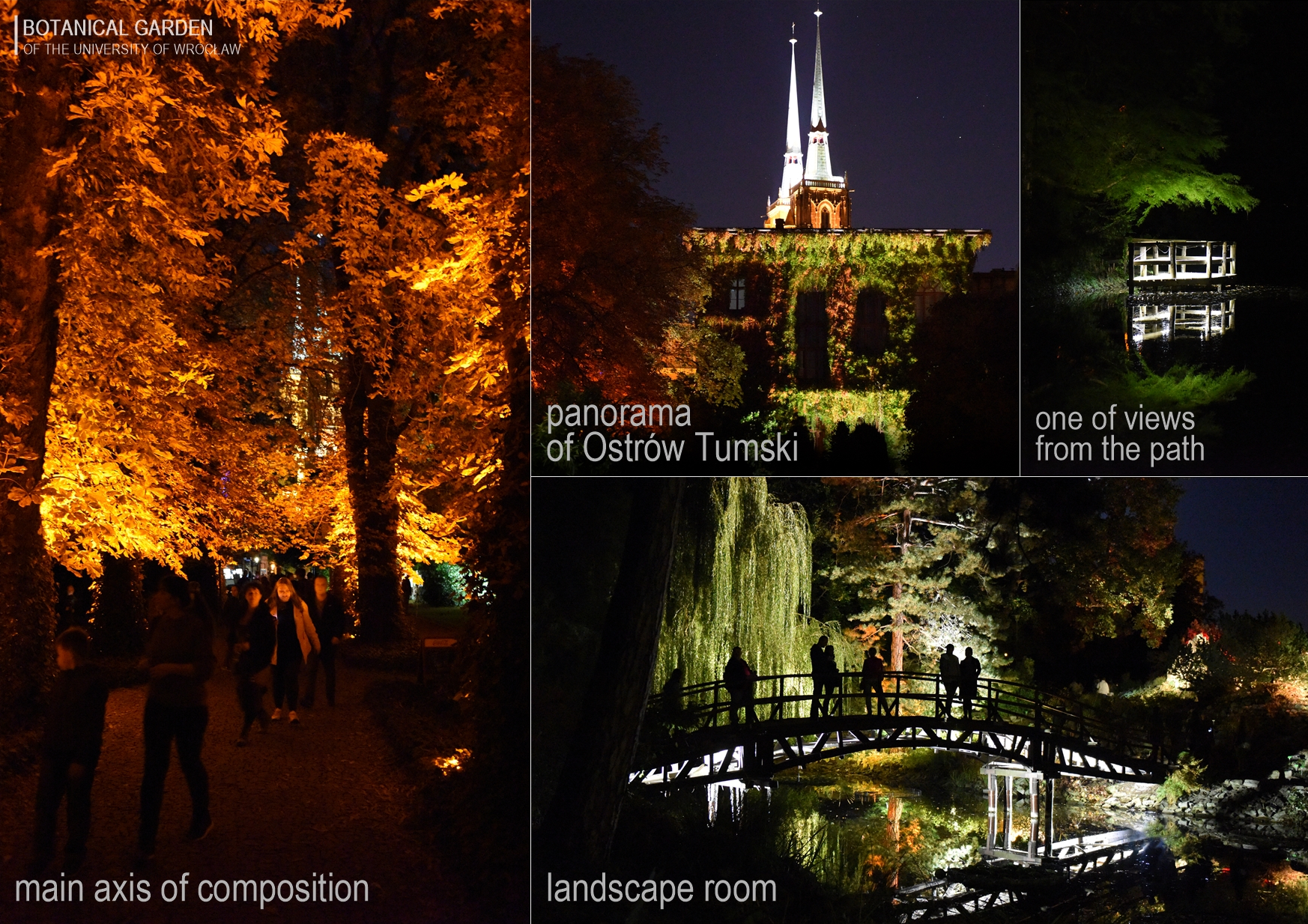
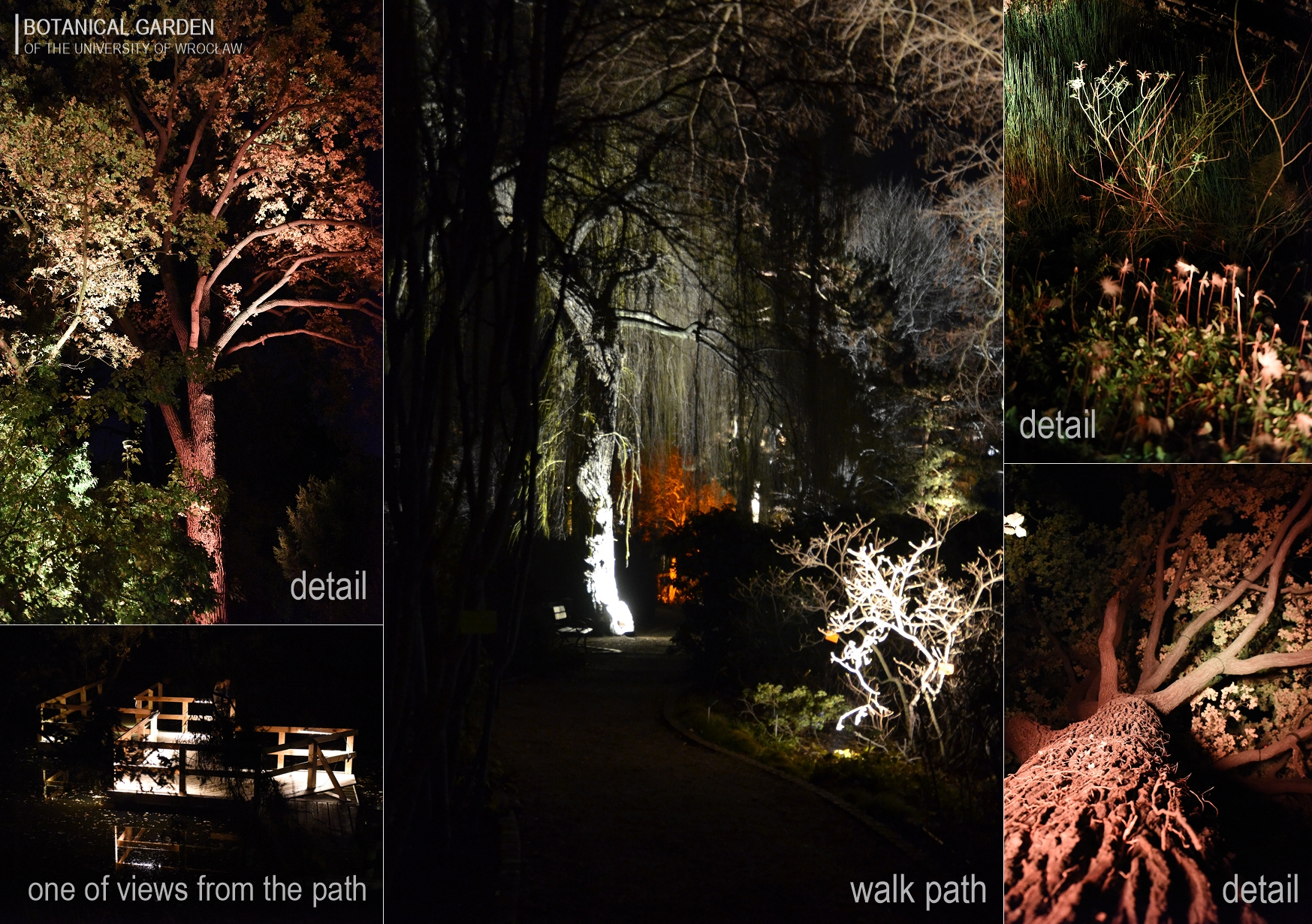

@Magdalena Zienowicz (Wrocław University of Environmental and Life Sciences), 2021
Content licensed to the European Union.